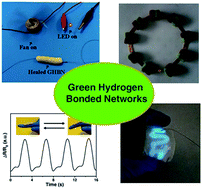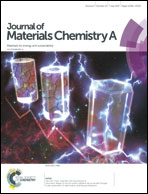Healable green hydrogen bonded networks for circuit repair, wearable sensor and flexible electronic devices†
Abstract
Healable materials have wide applications, particularly in flexible electronics. Developing healable materials with green preparations, manipulations and post-processes, and moderate healing conditions is still a challenge. Herein, inspired by the natural healing phenomena based on hydrogen bonding interaction, a green hydrogen bonded network (GHBN), a hydrogel consisting of eco-friendly materials and connected by hydrogen bonding interaction, that is healable, reshapable, injectable, conductive, renewable, cost-effective and eco-friendly is fabricated using amylopectin/water as the skeleton and free-moving ions as the current carrier. This ternary GHBN can heal rapidly in both mechanical and electrical fields at room temperature. The healing process lasts just 2–3 s without any specific environment, and the healing efficiency reaches 98%. The mechanisms of hydrogen bonded network formation and the healing process are well studied by computational simulations. The GHBN exhibits excellent performance in circuit repair, wearable sensors and flexible electronic devices. This study provides a new strategy to develop electrode materials using natural hydrogen bonded molecules as skeletons that may be applied as flexible electronics.



 Please wait while we load your content...
Please wait while we load your content...